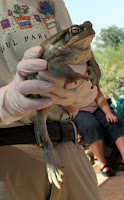 |
| KL and Leo meet for the first time |
Leo began his career in “show business” as a very small young snake who crawled into the bedroom of Ed Moll, a retired herpetologist who devoted a great deal of time to educating people of all ages about the marvels of reptiles. Ed was delighted to see Leo, since he hoped to add a kingsnake to his programs. Naming the snake was easy: Leo the king. (Snakes that eat other snakes, such as the king cobra, are often called “kings.” The most common, widespread North American snake with this feeding habit is the beautiful common kingsnake, Lampropeltis getula.)
 |
| Ed Moll with his gopher snake, Bruno |
In 2010 I became one of the docents privileged to participate in the “Ramble.” My duties included showing exhibits (such as a turtle carapace or snake skeleton) to our audience, and holding and talking briefly about one of the animals. Though I generally only got to participate two or at most three times a month, Reptile Ramble quickly became my favorite activity at the Park. And my favorite snake was always Leo, so much so that I asked to have him as often as possible.
 |
| Scenes from the Ramble |
All
of our snakes were accustomed to being held, talked about, and even
touched by visitors. But Leo seemed to me to have a special knack for
putting nervous humans at ease. He was always calm, gentle, and
cooperative, and those who worked up their courage to touch him often
seemed to melt when they found how soft, smooth, and nonthreatening
he was. I loved that moment when a person who was previously fearful
of snakes suddenly relaxed and smiled. I felt a special affinity with
Leo. Holding him was soothing to me, and after a while I felt he
recognized me in a very laid-back kind of way.
Though our purpose at Reptile Ramble was serious, the demeanor was often silly, with Ed and his colleague trading quips like a couple of comedians. We docents joined in when and where we could. On days when I was showing Leo, telling visitors that he was the most beautiful snake on the planet, Ed often contradicted me by showing his mountain kingsnake, a cousin of the common king, with bright red, cream, and black stripes. “This,” Ed would tell the audience, “Is real beauty.” “There is a big difference between beauty and gaudiness,” I would scoff in reply. This “argument” almost always involved the audience members, who sometimes even voted on the most beautiful snake. (Thanks to my tireless advocacy, Leo often won.)
In 2012 I was thrilled when Ed asked me to babysit Leo for the summer. Before heading off to Wisconsin, Ed dropped Leo and his terrarium off in my guest room, along with a supply of frozen mice. (See The Snake in My Guestroom. and Feeding a Snake.) I so enjoyed watching Leo and occasionally taking
him out to hold. I didn't even mind thawing the frozen mice. There was only one problem: Leo shed his
skin a week after I took him, and then again three weeks later. I
knew that wasn't normal, so I called Ed, who asked me how much I was
feeding his snake. “Two mice every week,” I responded. “Just as
you told me.” I could almost see Ed shaking his head in
exasperation. “I told you two mice every TWO weeks,” he said.
Oops. So Leo went on a diet for a while, then resumed his normal
feeding schedule.Though our purpose at Reptile Ramble was serious, the demeanor was often silly, with Ed and his colleague trading quips like a couple of comedians. We docents joined in when and where we could. On days when I was showing Leo, telling visitors that he was the most beautiful snake on the planet, Ed often contradicted me by showing his mountain kingsnake, a cousin of the common king, with bright red, cream, and black stripes. “This,” Ed would tell the audience, “Is real beauty.” “There is a big difference between beauty and gaudiness,” I would scoff in reply. This “argument” almost always involved the audience members, who sometimes even voted on the most beautiful snake. (Thanks to my tireless advocacy, Leo often won.)
 |
| Leo relaxing on top of the "cave" in his terrarium |
 |
| Taking a postprandial soak |
I
stopped working Reptile Ramble in 2014, when I began volunteering at
the Arizona-Sonora Desert Museum.
Although in my new docent work I had a weekly opportunity to
interpret snakes of various species, including kingsnakes, none of
them were like Leo. I still missed him and occasionally visited him
in Ed's pantry.
Early
in 2018 Ed retired from doing herpetological programs, and found
other homes for his animals. He agreed that Leo/Leonora would be an
ideal addition to the Interpretive Animal Collection at the Desert
Museum, and when the director of the program agreed, I picked up Leo
and one of his compadres and drove them out to the Museum. I was
excited at the thought of getting to interpret this beautiful,
simpatico snake again, and wondered if he would remember me.
Alas,
I never saw him again. A few weeks after he went into quarantine for his new job, the
snake vet discovered that Leo had advanced kidney cancer, and
euthanized him. I still cry when I think about him. He had his own
charm and personality, and I will always feel he knew me and approved
of my efforts to save the world one snake at a time.
Rest
in Peace, sweet, beautiful Leo the Kingsnake.





